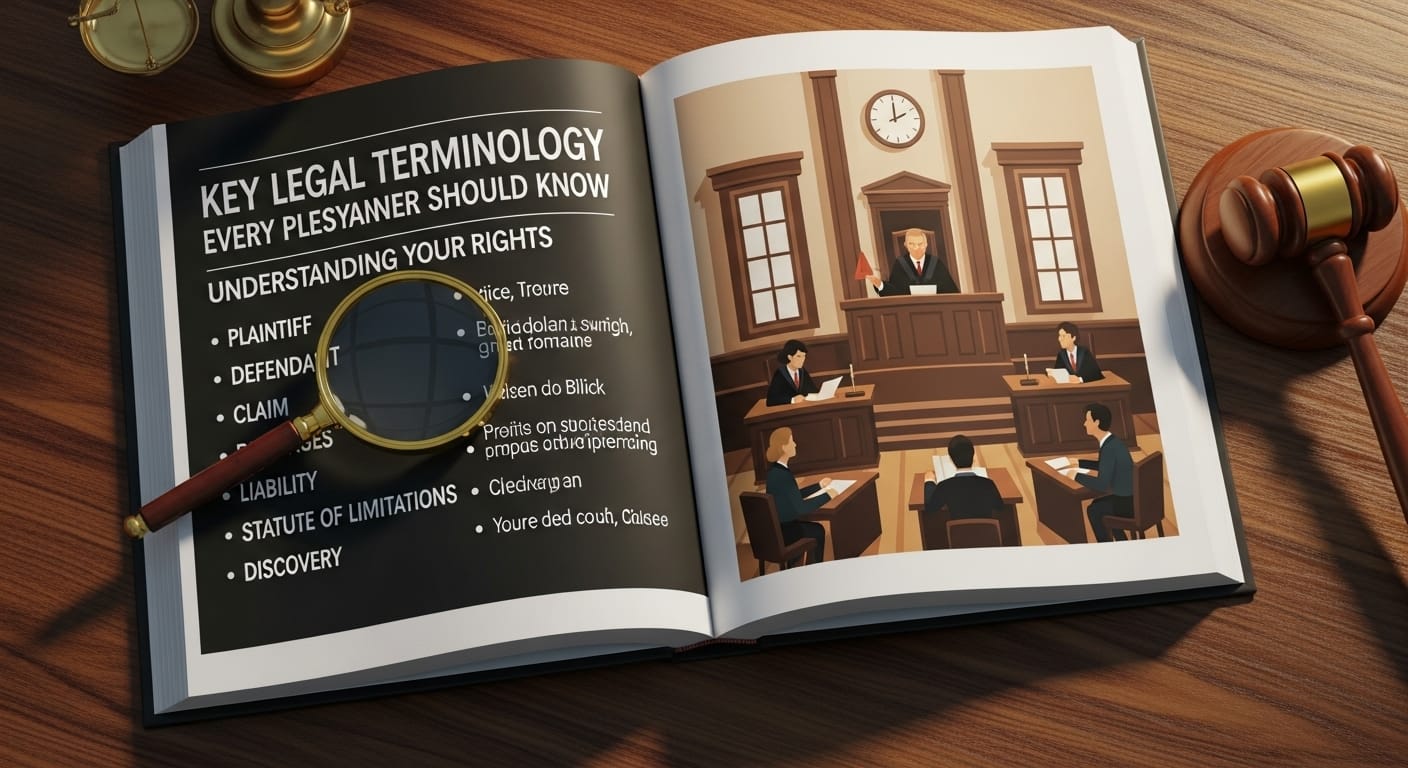Please Note: This post may contain affiliate links. If you click one of them, we may receive a commission at no extra cost to you. As an Amazon Associate, I earn from qualifying purchases.
So, you’re thinking about suing someone. Maybe they backed into your car while trying to parallel park (which is always a risky move) or maybe they owe you money for that one time you lent them $20 and never saw it again.
Whatever the case, if you’re stepping into the legal arena, you’ll want to arm yourself with some key legal terminology. Trust me; knowing these terms can make all the difference between sounding like a savvy plaintiff and someone who just wandered in off the street.

Top Takeaways and Key Concepts
Know the Roles: Identify yourself as plaintiff and understand the defendant’s position in your case.
Understand Torts: Determine if the harm is intentional, negligent, or strict liability to guide your claims.
Learn About Damages: Know the difference between compensatory and punitive damages to set realistic expectations.
Grasp Burden of Proof: Collect sufficient evidence to meet the plaintiff’s responsibility of proving your claim.
Consider Settlements: Explore negotiation options to resolve disputes efficiently without lengthy courtroom battles.
Summary of This Article
The article explains key legal terms for anyone considering a lawsuit. It clarifies the roles of plaintiff and defendant, types of torts, and the distinctions between compensatory and punitive damages. Understanding the burden of proof helps plaintiffs gather sufficient evidence to support their case. Finally, it highlights settlements as a practical alternative to litigation, saving time, stress, and costs. These insights provide a foundational understanding for navigating civil legal disputes confidently.
Plaintiff vs. Defendant: The Main Characters

Let’s start with the basics: who are these people? In any court case, there are usually two main players—the plaintiff and the defendant. You, my friend, are the plaintiff if you’re bringing a lawsuit against someone.
It’s like being the hero of your own story—except instead of battling dragons, you’re fighting for justice (and maybe some cash).
On the flip side, we have the defendant. This is the person or entity being sued. Think of them as the villain in your courtroom drama—though sometimes they might not be as evil as they seem!
I once had a friend who was convinced his neighbor was out to get him over a fence dispute. Turns out, it was just a misunderstanding about property lines! But hey, that’s how it goes.
Understanding this distinction is essential because it sets up everything else in your case. As a plaintiff, you’re essentially saying, “Hey! This person did something wrong!” while the defendant gets their chance to say, “Wait a minute!”
Tort: What on Earth Is That?
Next up is “tort.” No, it’s not what you eat at birthday parties (that would be cake). A tort is basically a fancy word for when someone does something wrong that causes harm to another person. It’s like when someone spills coffee on your favorite shirt because they were too busy scrolling through cat memes—definitely not cool!
Torts can range from minor accidents to major disasters. There are three main types: intentional torts (where someone purposely causes harm), negligence (when someone fails to act responsibly), and strict liability (where responsibility exists regardless of fault).
Knowing which type applies to your situation can help clarify what kind of compensation you might seek.
When I got rear-ended by an overly enthusiastic driver during rush hour once—a classic example of negligence—I learned firsthand how important it is to understand torts. My lawyer explained that I could pursue damages based on medical bills and pain and suffering due to this unfortunate event.
Damages: Show Me The Money!
Speaking of damages—let’s talk about what that means in legal lingo! Damages refer to money awarded to compensate for loss or injury caused by someone’s actions or negligence. Think of it as getting reimbursed for that expensive latte your clumsy friend spilled all over you last week (not bitter at all).
There are two main types of damages: compensatory and punitive. Compensatory damages aim to cover actual losses—like medical bills or lost wages—while punitive damages serve as punishment for particularly bad behavior by the defendant (like texting while driving!). It’s like icing on top of an already delicious cake.
Interestingly enough, understanding how damages work can help set realistic expectations for your case outcome. You want fair compensation but remember—you’re not going to win millions unless you’ve got something truly outrageous happening here!
Burden of Proof: The Heavy Lifting
Now let’s dive into “burden of proof.” This term sounds heavy because… well, it is! The burden of proof refers to who has the responsibility to prove their claims in court. Typically, it’s on you as the plaintiff since you’re making allegations against someone else.
In civil cases (like most lawsuits), this burden requires proving your case by a “preponderance of evidence.” Sounds fancy? Basically, it means showing that it’s more likely than not that what you’re claiming is true—think 51% certainty rather than 100%.
I recall my own experience during my neighbor’s fence saga where I had plenty of photos documenting our property line—and yet somehow felt like I needed even more evidence just because he claimed he didn’t see anything wrong! It taught me how crucial this concept can be when building your argument effectively.
Settlement: The Art of Compromise
Lastly—and perhaps most importantly—is “settlement.” This is where things can get interesting! A settlement occurs when both parties agree on an amount before heading into court—kind of like haggling over prices at a garage sale but with way more paperwork involved.
Settlements can save everyone time and stress; after all, nobody wants courtroom drama unless there’s popcorn involved! Many cases settle outside court simply because litigation can be lengthy and costly—not exactly ideal if you’d rather spend those resources elsewhere!
I remember hearing about one guy who settled his personal injury claim over hot wings at his favorite restaurant instead of dragging things through trial—and honestly? That sounds much better than waiting around in stuffy courtrooms!
Suggested Resources:
Understanding Legal Terms
https://www.nolo.com/legal-encyclopedia/understanding-legal-terms.html
The Basics of Civil Litigation
https://www.lawyers.com/legal-info/research/the-basics-of-civil-litigation.html
How To Prepare for Court
https://www.courts.ca.gov/documents/preparing_for_court.pdf
Legal Glossary
https://www.findlaw.com/glossary.html
Courtroom Etiquette Tips
https://www.nolo.com/legal-encyclopedia/courtroom-etiquette-tips.html
Frequently Asked Questions
Who is the plaintiff in a lawsuit?
The plaintiff is the person or party who files a lawsuit, claiming they were harmed by the defendant’s actions and seeking compensation or legal remedy.
What is the role of the defendant in a case?
The defendant is the person or entity being sued. Their role is to respond to the plaintiff’s claims and defend against the allegations made in the lawsuit.
What does the term “tort” mean in legal cases?
A tort is a wrongful act that causes harm to another person, such as negligence, intentional harm, or strict liability, forming the basis for many civil lawsuits.
What are compensatory and punitive damages?
Compensatory damages reimburse actual losses like medical bills or lost wages, while punitive damages punish particularly reckless or harmful behavior by the defendant.
What does “burden of proof” mean in civil law?
The burden of proof is the plaintiff’s responsibility to show that their claims are more likely true than not, usually by presenting strong evidence and documentation.
Why are settlements common in lawsuits?
Settlements allow both parties to resolve disputes without going to trial, saving time, money, and stress while ensuring an agreed-upon resolution.
Why is understanding legal terminology important for plaintiffs?
Knowing key terms like plaintiff, tort, and damages helps plaintiffs communicate effectively with attorneys, understand court procedures, and make informed decisions.

Kevin Collier is a legal expert passionate about simplifying complex legal concepts for everyday individuals. With a focus on providing clear, practical information, he covers a wide range of topics, including rights, responsibilities, and legal procedures. Kevin aims to empower readers with the knowledge they need to navigate the legal landscape confidently, ensuring they can make informed decisions regarding their legal matters. Through insightful articles and easy-to-understand resources, he helps demystify the law, making it accessible to all.










